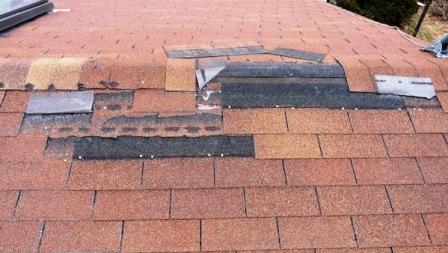Mastering Roof Inspections: Asphalt Composition Shingles, Part 53
by Kenton Shepard and Nick Gromicko, CMI®
The purpose of the series “Mastering Roof Inspections” is to teach home inspectors, as well as insurance and roofing professionals, how to recognize proper and improper conditions while inspecting steep-slope, residential roofs. This series covers roof framing, roofing materials, the attic, and the conditions that affect the roofing materials and components, including wind and hail.
Creased or Broken Tabs

Once the bond of the adhesive strip is broken, wind may be able to lift and bend the shingle tabs to the point that they crease or tear.

Low-quality and older shingles will crease and tear at low wind speeds.
It’s rare that inland, non-tornado wind can break the bond of a fully bonded shingle tab. Bear in mind that just because the underside of a shingle is stained with adhesive does not prove that the adhesive strip ever bonded fully. Under certain circumstances, adhesive can be thinned by excessive heat, causing the tab to separate prior to final curing.
If a bond of the adhesive strip is broken by wind, it’s often because the shingle never completely bonded along its full length. Typically, a poorly bonded section will be lifted by wind, and this will gradually cause the remaining sections to fail. Sections of the bond may be compromised by fasteners installed in the adhesive strip or by debris.
Debris
Another potential problem with failure of the adhesive strip's bond is that debris, such as dust and dirt, may be blown into the adhesive strip. This can limit or prevent shingle tabs from bonding, leaving them more vulnerable to wind damage.
Shingles with adhesive strips contaminated by debris may need to be hand-sealed.
Shingle Blow-Off
If wind blows hard enough, it may be able to pull shingles over the heads of fasteners. Poor installation practices, such as over-driving or placing fasteners improperly, increase the chances of shingle blow-off.

**************************************************
Learn how to master a roof inspection from beginning to end by reading the entire InterNACHI series: Mastering Roof Inspections.
Take InterNACHI’s free, online Roofing Inspection Course
Mastering Roof Inspections
Roofing Underlayment Types
Inspecting Underlayment on Roofs
Fall-Arrest Systems
Roofing (consumer-targeted)
More inspection articles like this

